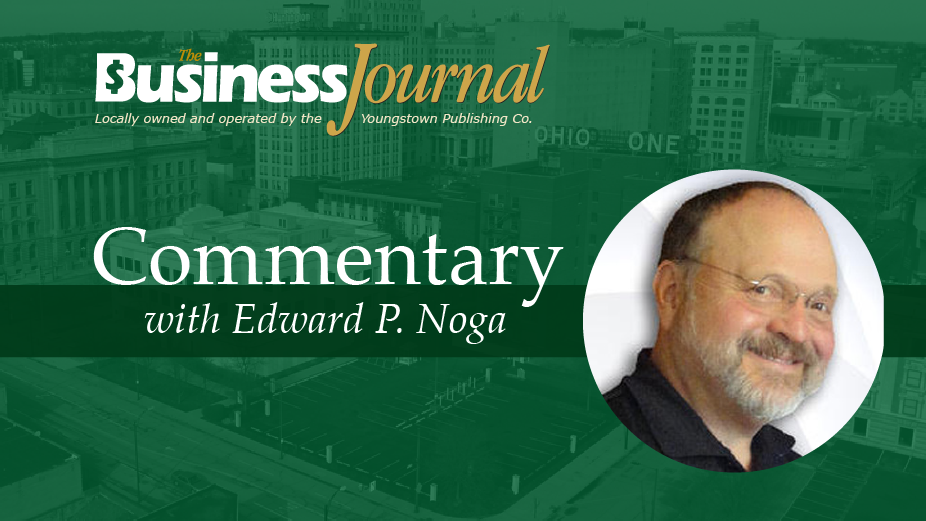By Edward P. Noga
YOUNGSTOWN, Ohio – A recent article in this publication reported insightful comments concerning the Voltage Valley concept taking hold in our region. It is replacing the Rust Belt label.
At one point, mention is made that people in other cities in the Midwest (and even New York City) write about the Youngstown/Warren area. The author commented that we should be writing the narrative that tells people who we are. This narrative is being written on various levels.
In 1859, Charles Dickens published “A Tale of Two Cities” about London and Paris during the French Revolution. His novel is timeless because it shares what the narrator and characters say, but equally and maybe more important, it shares what they do.
It is a classic because it balances chapters about social opposites happening simultaneously.
When I was born, my parents lived on the west side of Youngstown. As a pastor, I spent half of my life on the South Side. I grew up when everyone believed the sky was the limit for our Valley. Maybe the sky was the limit be-cause the skies above the Valley were filled with the fire and smoke and smell of steelmaking. We were known around the world for what we did here.
I have always loved my hometown and was thrilled when I retired that I was able to move downtown in the city that John Young founded back in 1797.
Over the past three years living downtown, I have been able to witness the changes and development of our central city and Youngstown State University. I can remember, about two decades ago, when I had a seminary student living with me for the summer at St. Patrick Parish. He was from one of the first ring smaller cities/suburbs that surround the city. After he had been in residence a few months, I asked him what his experience was growing up where he did, in relation to the city.
Sadly, he responded, “Depending on where I was going, it was a place I had to drive through at times.”
I asked whether there was a time when something or somebody or somewhere made the city a destination.
He responded, “Rarely!”
Given modern communications and travel being what they are (in relation to my younger years), my opening reflection on “A Tale of Two Cities” is likely replicated in other parts of the region (and nation). With that as background:
As pastor of a church where the majority of parishioners grew up on the South Side but moved out for many and various reasons, I often heard that their “coming back home” was a way of acknowledging how important their upbringings were. In addition, the parish offered a way of remaining connected to the city of their origin.
Interesting.
As I take part in the various activities that now happen in the downtown/YSU area, I realize that in many respects, participation in sporting events, entertainment, worship, culture, fundraising and leisure within the city succeeds because many folks from outside come in to participate.
Also, some of the major events – Streetscape, the Youngstown Flea, the YSU Festival of the Arts, the Luke Bryan Y-Live concert, the Panerathon and numerous others – succeed because people choose to come in to the city and participate. Even the DoubleTree by Hilton hotel is open because people come from outside.
All of the above is encouraging and positive. That is, the tale of the first city I call home.
Unfortunately, there is also the tale of the second city.
At a recent community meeting, a respected and influential person sat next to me and said, “I will do anything for institutions and initiatives in [his emphasis] the city. But I will not work with the city!” I was surprised at the statement but it was followed by a litany of occasions when phone calls were not returned, emails were not responded to and, for him, a general feeling of the city’s indifference.
Recently, local media followed the story of an outlying community whose water system is outspending its income. Leadership suggested that one possibility was to sell the system.
Although citizens’ responses at the meeting were cool to the idea, some who stood in front of the microphone were downright cold to the idea of selling to Youngstown. The word untrustworthy came up too many times.
On a very personal level, in the evenings or on weekends – just about every time I am out – I’m telling a couple or a family that the parking meters are not in use after 5 p.m. on weekdays and not at all on weekends.
Usually, the response is “Really?” They then proceed to share what their friends tell them about the parking enforcement officers just waiting to ticket everyone.
My three examples are just that – examples. As such, you might challenge and refute them. Most stories have more than one side. They do, however, convey a suspicion that the city is not open for business and that public service takes a back seat to public power.
So many community leaders and volunteers and interested citizens work daily to tell and ensure the tale of the first city is out there and promoted. Let’s do all we can to diminish the negativity of the tale of the second city.
We live in the best of times. We live in the worst of times, as Dickens wrote. We are writing the narrative for our future. We are open for business. Let’s make sure that that narrative complements what we are doing.
